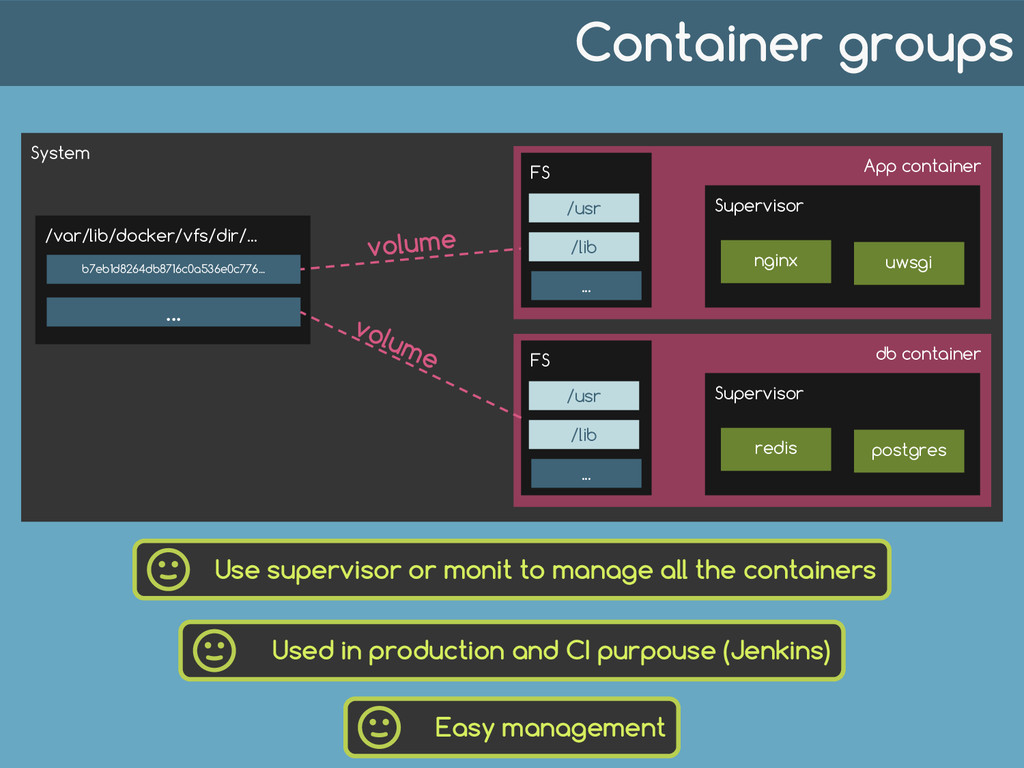

In this paper, we propose an approach for assisting However, optimizing the migration of microservicesįrom one fog environment to other while assuring certain quality is still a big issue It is based on microservices to provide severalĪdvantages over a monolithic solution, such as autonomy, composability, scalability,Īnd fault-tolerance.
Monit docker containers software#
Microservice architecture is anĮmerging software architectural style. To fully leverage capabilities of fog devices. Microservices-based Smart Grid applications within fog environments has the potential Since this conceptĪligns with the goals of microservices architecture (MSA), efficient placement of Nature of the fog computing nodes, fog applications need to be developedĪs a collection of interdependent, lightweight modules. Due to the distributed, heterogeneous and resource constrained Offers a place for collecting, computing and storing smart meter data before transmitting That are hard to process, analyze and store. In a large Smart Grid, smart meters produce tremendous amount of data Two new methods are presented,Įach providing a detailed picture of the distributed system, while being better suited for different use cases,ĭepending on the environmental constraints. Taken to extract information from messages, and achieve advanced analysis. These shortcomings and open the door to more versatile tracing tools. New tracing methods are proposed to address Actual tracing solutions for this task wereĬompared to identify shortcomings and possible improvements.

Losses and slowdowns on this type of infrastructure is a challenge. The execution of distributed applications, as well as a deeper input for analysis. Inter-container communications, with Message Oriented Middleware, provide insight into Thence, conventional messaging systems have evolved and adapted to increasing loadsĪnd Edge Computing. However, this implies a reliable communication system between computing elements By linking with open-source software, the development was improved and a datadog-based container monitoring system, built to enable real-time anomaly detection, was implemented.Ĭontainers are increasingly used for software deployment, because of the modularity they offer for packagingĪnd isolating applications. Herein, for small- and medium-sized manufacturing enterprises transitioning onto the cloud, we introduce a Docker Container application architecture, a customized container-based defect inspection machine-learning model for the AWS cloud environment developed for use in small manufacturing plants. However, small- and mid-sized manufacturers are struggling with their digital transformation owing to technological barriers. Many companies are also introducing container virtualization technology to maximize their cloud transition and cloud benefits. Large companies are building enterprise-wide hybrid cloud platforms to further accelerate their digital transformation. Manufacturers are expanding their business-process innovation and customized manufacturing to reduce their information technology costs and increase their operational efficiency. pid with pidfile / run / monit - docker / foo_php_fpm. mem with path "/usr/bin/monit-docker -s running -name foo_php_fpm monit -rsc mem_percent" group monit - docker if status > 100 for 2 cycles then alert if status > 70 for 2 cycles then alert if status > 80 for 4 cycles then exec "/usr/bin/monit-docker -name foo_php_fpm monit -cmd '(kill -USR2 1)'" check program docker. cpu with path "/usr/bin/monit-docker -s running -name foo_php_fpm monit -rsc cpu_percent" group monit - docker if status > 100 for 2 cycles then alert if status > 70 for 2 cycles then alert if status > 80 for 4 cycles then exec "/usr/bin/monit-docker -name foo_php_fpm monit -cmd reload" check program docker. status with path "/usr/bin/monit-docker -name foo_php_fpm monit -rsc status" group monit - docker if status = 114 for 2 cycles then alert # container not found if status != 0 for 2 cycles then exec "/usr/bin/monit-docker -name foo_php_fpm monit -cmd restart" # container not running check program docker. Monit-docker -image '*/php-fpm/*' monit -cmd '(bash -c " & kill -USR2 1")'Ĭheck program docker.

Reload php-fpm in container with image name contains /php-fpm/ if /dev/shm percentage usage greater than 80%: Monit-docker monit -name 'bar*' -name 'foo*' -cmd-if '60 > cpu_percent 100 MiB ? (kill -USR2 1)' Stop containers with name starts with bar or foo and if cpu usage percentage greater than 60% and less than 70%: Monit-docker monit -name 'foo*' -cmd-if 'mem_percent > 60 ? restart' -cmd-if 'cpu_percent > 90 ? restart' Restart containers with name starts with foo if memory usage percentage > 60% or cpu usage percentage > 90%:


 0 kommentar(er)
0 kommentar(er)
